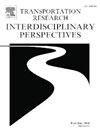两杯酒和驾驶:评估普通司机在驾驶时对酒精和药物使用的自我约束能力
IF 3.8
Q2 TRANSPORTATION
Transportation Research Interdisciplinary Perspectives
Pub Date : 2025-04-28
DOI:10.1016/j.trip.2025.101391
引用次数: 0
摘要
在这项研究中,参与者回答了7个关于他们在驾驶时抑制物质使用的能力的问题,以及社会人口统计学问题。共有360名无违规司机完成了问卷调查。略多于一半(51.8%)的非违规司机承认在喝了1到2杯啤酒或葡萄酒后开车。此外,15%的司机还说他们服用过其他药物,包括可卡因、安非他明或特制药物(8%),以及导致嗜睡的药物。此外,与新手司机相比,有经验的司机在驾驶时表现出更高的不抑制物质使用的倾向。研究发现,在饮用超过3杯啤酒或葡萄酒后不久驾车的报告与审计诊断为中度风险或酒精使用障碍之间存在重要联系。此外,除了对服用药物或非处方药后驾驶的问题作出肯定回答外,还发现在吸食大麻、大麻或大麻后驾驶的报告与审计和DAST诊断之间存在显著关系。此外,喝了1 ~ 2杯啤酒或葡萄酒后开车的司机也报告了更高的物质损失事故。那些喝了5杯或5杯以上烈性酒后驾车的人被罚款的数量也更高。此外,酒后驾车的司机自我报告的违规、攻击性违规、错误和失误的比例也更高。最后,不安全行为、违规和错误也与使用第二种物质,主要是大麻有关。本文章由计算机程序翻译,如有差异,请以英文原文为准。
Two drinks and drive: Assessing the average driver’s ability to self-restrain from alcohol and drug use while driving
In this study, participants answered 7 questions about their ability to restrain from substance use while driving, as well as socio-demographic questions. A total of 360 non-offender drivers completed the questionnaires. Slightly more than half (51.8%) of the non-offender drivers admitted to driving after consuming 1 or 2 beers or glasses of wine. Moreover, 15% of drivers also said they had taken other drugs, including cocaine, amphetamines or designer drugs (8%), and medications that cause drowsiness. Additionally, experienced drivers showed a higher tendency to not restrain from substance use while driving compared to novice drivers. An important link was found between reports of driving shortly after consuming more than 3 beers or glasses of wine and an AUDIT diagnosis of either moderate risk or alcohol use disorder. Moreover, significant relationships were found between reports of driving after consuming cannabis, hashish or marihuana and an AUDIT and DAST diagnosis in addition to an affirmative response to the question about driving after taking drugs or non-prescription medications. Furthermore, drivers who reported driving after consuming 1 or 2 beers or glasses of wine also reported a higher number of accidents with material damage. The number of fines was also higher for those who reported driving after consuming 5 or more spirit drinks. Additionally, drivers who drink and drive also self-reported a higher rate of violations, aggressive violations, errors and lapses. Finally, unsafe behaviours, violations and errors were also associated with the use of a second substance, mainly cannabis.
求助全文
通过发布文献求助,成功后即可免费获取论文全文。
去求助
来源期刊

Transportation Research Interdisciplinary Perspectives
Engineering-Automotive Engineering
CiteScore
12.90
自引率
0.00%
发文量
185
审稿时长
22 weeks
 求助内容:
求助内容: 应助结果提醒方式:
应助结果提醒方式:


